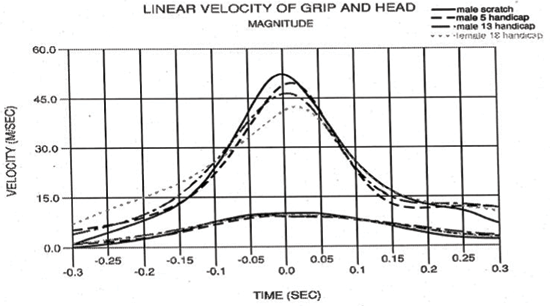A THREE DIMENSIONAL KINEMATIC AND KINETIC STUDY OF THE GOLF SWING
Steven M. Nesbit
Department of Mechanical Engineering, Lafayette College, Easton, PA, USA
Received 20 May 2005
Accepted 02 September 2005
Published 01 December 2005
© Journal of Sports Science and Medicine (2005) 4, 499 - 519
http://www.jssm.org/vol4/n4/17/v4n4-17text.php
Steven M. Nesbit
Department of Mechanical Engineering, Lafayette College, Easton, PA, USA
Received 20 May 2005
Accepted 02 September 2005
Published 01 December 2005
© Journal of Sports Science and Medicine (2005) 4, 499 - 519
http://www.jssm.org/vol4/n4/17/v4n4-17text.php
re more convincing....
I'm not here to sell you anything. I'm not going to try to "close the deal". I'm showing you the way it is... take it or leave it. Models are well.. a model (profound I know) and that's why the modeler must scrutinize carefully what elements get included. Ever hear the term: GIGO?... garbage in garbage out. As far as "the CF model" goes... what model? We're still waiting on a mandrin to produce a "CF model". He showed a simple compound pendulum with a constant hub torque. I outlined some of the deficiencies in that approach to modeling a golfer's swing in an earlier post.
If I were asked to design and build a "pingman".... I would pull out a compound pendulum model, like mandrin's, and use it to size the hub drive mechanism appropriately. If I wanted to model a golfer's swing (and did'nt have access to the software Nesbit uses) I would take an approach similar to the one I outlined. It would be a (parametric) model so I could adjust the variables that matter and I would optimize (given practical constraints). That's a way to see (mathematically) just what might be possible (in the way of say club head speed).
As far as the slowing hands myth goes... Nesbit's test results disproved it:
http://www.jssm.org/vol4/n4/17/f4.gif

All golfers tested had nearly identical hand velocity profiles (which is quite intriguing by itself) and none exhibited significant slowing prior to impact. That's not to say a golfer can't have slowing hands. Clearly they can as shown by the photographic evidence Dante produced in defense of the now falsified COAM myth. But its NOT a requirement (for "the energy to "flow" out to the clubhead")

I do recall reading Nesbit mention CF with respect to release. He's no fool so I asked myself... why would he do that? Just speculation but... Academics are in a never-ending search for money; research funds grease the wheels of higher education. Professors are not unlike politicians in that regard.
From what I gather, funding for Nesbit's (golf) research comes from two sources: USGA and NSF. We know how ensconced the CF myth is in the golfing establishment. Heck the author of nearly every golf book published in the past century blathers on about it. Of course repeating a myth (like the CF myth) over and over again and again does not make it less false but what it does do is cement the misconception in the minds of the impressionable. If I were Nesbit I might choose not to fight the CF battle (and risk pissing off my funders) either...


